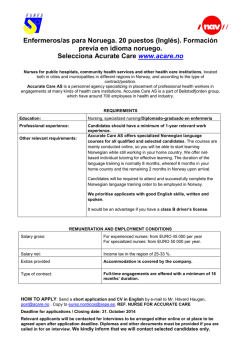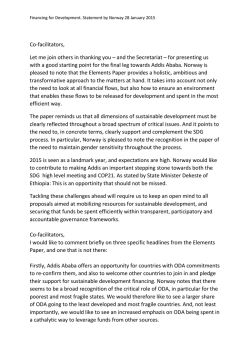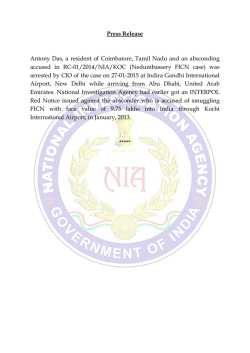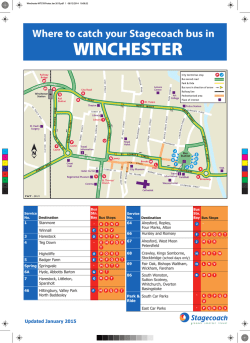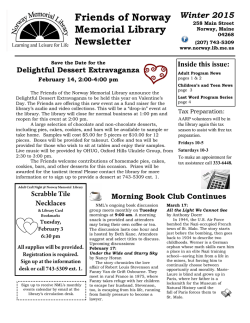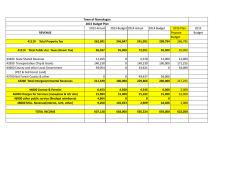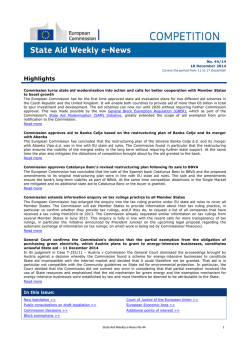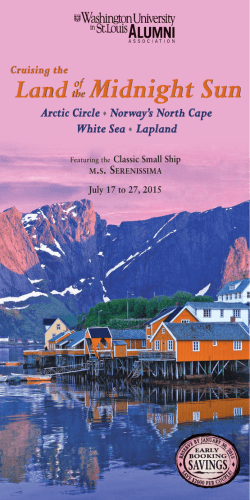
Faculty of Health and Social Studies
Telemark University College Faculty of Health and Social Studies PRE-ARRIVAL GUIDE 2014 - 15 International Exchange Students The Faculty of Health and Social Studies at Telemark University College campus Porsgrunn welcomes exchange students mainly from Europe. We are happy to involve them in a positive, thriving and multi-cultural student community. The following sections are intended to give practical information to help you with your preparations before you arrive and to give you an idea of what life will be like as a student at the Faculty of Health and Social Studies in Porsgrunn. If you have any further questions that you don’t find the answer to in this guide, please contact the Faculty’s International CoordinatorOffice at this address: [email protected] We hope that you will find our guide helpful. Yours sincerely Rolf Heimdal International coordinator Contents: 1. 1.1 1.2 1.3 GENERAL INFORMATION………………………………………… p. 3 Telemark University College Faculty of Health and Social Studies in Porsgrunn Academic calendar and deadlines 2. BEFORE YOU ARRIVE……………………………………………… p. 4 2.1 Important information and musts 2.2 Formalities (residence permit, work permit, etc.) 3. 3.1 3.2 3.3 ACCOMMODATION………………………………………………… p. 5 Student dormatories Equipment Costs 4. INSURANCE…………………………………………………………... p. 6 4.1 Health Insurance coverage on planned transportation 4.2 Special needs for health and safety 5. 5.1 5.2 5.3 HOW TO GET TO PORSGRUNN…………………………………... p. 6 Airplane From airport to Porsgrunn When you arrive in Porsgrunn 6. 6.1 6.2 6.3 6.4 6.5 6.6 6.7 6.8 LIVING IN TELEMARK – NORWAY……………………………... p. 8 Climate The locals Picture gallery Eating habits Medical matters Electricity Telephone and Internet Costs of living in Norway 7. CAMPUS LIFE………………………………………………………... p. 11 7.1 International Student Union Telemark 8. 8.1 8.2 8.3 PRACTICAL INFORMATION/FAQ……………………………….. p. 12 Questions about clothing Questions about academic and social life Gifts 9. LINKS………………………………………………………………….. p. 14 2 1. GENERAL INFORMATION 1.1 Telemark University College Telemark University College (TUC or “Høgskolen i Telemark” in Norwegian) is a fullyaccredited state college in Norway, with more than 6500 full-time students and 600 faculty and staff members. TUC offers a wide variety of study programmes and degrees. Telemark University College participates in several European and international exchange agreements. TUC is actively involved in programmes such as Erasmus (European exchange), Nordplus (Nordic exchange) as well as bilateral exchange agreements. TUC received its name from the region where it is situated. Telemark is one of nineteen counties in Norway and has a well-appointed location in southern Norway with varying seasons and climatic conditions offering snowy winters and sunny summers. With its idyllic coastline, beautiful rivers and canals, small industrial towns, gentle countryside and wild mountains; Telemark is attractive to international students seeking scenic diversity. People often describe Telemark as a miniature of Norway in terms of scenery. 1.2 Faculty of Health and Social Studies in Porsgrunn This faculty in Porsgrunn offers the following studies: 3 year B.Sc. degrees in Nursing, Social Education and Child Welfare Work, and 2 year M.Sc. degrees Multicultural Preventative Care with Children and Adolescents. The faculty also offers continuing educational programs within the field of Health and Social Work. There are approximately 2.000 students and 35.000 residents in the municipality of Porsgrunn. The history of our Faculty is of more than 100 years, and started with Nursing education in the county’s capital, Skien. This later developed to Telemark Nursing College (TNC). Telemark University College was established in 1994 when TNC together with three other independent colleges in our county merged. Porsgrunn is named after a small shrub called Pors (Myrica gale), which grows on marshy grounds along the banks of the river. The district of Porsgrunn is today part of a larger area named Grenland. Together with the countryside of Eidanger, Grenland gives a nice change between town and countryside. Porsgrunn has traditionally been an industrial melting pot for internationally known companies as Hydro, Statoil, INEOS, Eramet, Yara and REC ScanWafer. 3 1.3 Academic calendar and deadlines Deadline for Application: Erasmus students: May 1st or November 1st Arrival time has to be agreed upon. 2. BEFORE YOU ARRIVE 2.1 Important information 1. Please send by e-mail arrivaldate and time (including flight number and airport: Gardermoen, Torp or Rygge) to [email protected] as soon as they are available. 2. We strictly advice that you hopefully arrive in Porsgrunn weekdays, between 08 and 18. You will be met at the bus/train station, and showed to the lodgings. It might be difficult to order staff to work in the week-ends to take care of your arrival. 2.2 Formalities Visa information: EU/EEA citizens: An EU/EEA citizen can enter Norway with his or her ID document (passport). We do not offer any studies with duration shorter than one semester (about 6 months). You are therefore required to apply for a residence permit, and you should do this upon arrival at Telemark University College. You have to bring two passport photographs, your passport and your European Union Insurance Card. The residence permit is issued for one semester or one year depending on your study programme. If you are doing an exchange period of three months (practical placement), there is no need to register for a residence permit. Moving back: Before you move back to your home country, you must report this to the National Registry Office in your municipality. The office must receive your notification before you leave the country. On the form you have to fill in your current address and the address you are moving to and the date you move. 4 3. ACCOMMODATION 3.1 Student dormitories The Student Association (SiTel) will provide students with housing in single rooms at one of the several co-educational student dorms. Students share facilities with other Norwegian students and international students near the campus. Students cook their own food or they buy meals in the cantina. The same regulations will pertain to international students as to Norwegian students. All rooms have internet connections. Please note that there is limited telephone access from the dormitories. Most students bring along their own cellular/mobile phones, or purchase one after arrival. 3.2 Equipment The dorms are not equipped with kitchen utensils. Consequently all students must bring basic kitchen equipment with them or buy them after arrival. Bed equipment (pillow, pillow cover, duvet, duvet cover and bottom sheet) can be purchased for a small fee from SiTel (approx. 400,- NOK). You must bring your own towels or buy them. All dorms have free washers and dryers. 3.3 Costs Estimated expenses: Housing per month: Food and leisure per month: Books and study materials per semester 3.200,- NOK (approx.) 4.500,- NOK * 3.000,- NOK (approx.) * This may vary depending on personal spending habits (clothes, medicines, dental care, leisure activities etc.) In addition, please expect to pay for the following: Travel to and from the TUC Travel documentation, visa, etc. Personal travels and personal expenses (including travel insurance) Personal copying fees Membership in campus organizations Membership at local gym Participation in community activities, classes or clubs 5 4. INSURANCE 4.1 Health insurance coverage on planned transportation The student is responsible for travel insurance coverage for travel to and from Norway and for optional trips within Norway or Europe. Students can apply for health insurance during stay in Norway in a specified form given by the Norwegian Labour and Welfare Administration (a small patient’s fee must be paid). European students must remember to bring their EU Health Insurance identity card with them. The health scheme does not cover visits to optometrists or dentists. This plan does not cover theft or lost items however. It can be wise to check whether student travel offices offer student discount on insurance. 4.2 Special needs for health and safety All registered Telemark University College students may seek consultation from social and religious services provided by the college. Medical and dental services are available in Porsrunn. Informasjon about Telemark Students Association (SiTel) regulations for the health fund and refunding of fees in accordance with National Health Service Directions: http://www.sitel.no/english/sitel/regulations-for-the-health-fund 5. HOW TO GET TO PORSGRUNN 5.1 Airplane Norway has two airports in the proximity of Porsgrunn which operate on an international scale (plus a third one – not recommended): The closest airport to Porsgrunn (where our campus is situated) is called Sandefjord - Torp, or Oslo south (Sandefjord). International routes are by Wideroe/SAS, KLM and Ryanair. Oslo main airport (Gardemoen) is north of Oslo, having all international carriers. The last one, is called Oslo- Rygge, which is served by Ryanair. This one is impractical to use for Porsgrunn visits. You should then take a bus or train to Oslo, change there for a bus/train to Porsgrunn. It will take changes included aprox 5 hours. Keep in mind also arrival times that usually are impractical for Ryanair-flight. Oslo Lufthavn Gardemoen: http://www.osl.no/en/osl Sandefjord lufthavn Torp: http://www.torp.no/Default.aspx?Language=EN&pkMenu=131 Rygge lufthavn Rygge: http://www.en.ryg.no/ 6 Please note that sometimes luggage is delayed or disappear, therefore do not put important documents or fragile goods in the checked-in-luggage. Make sure that you put name tags on every piece of check-in luggage. Please check your airplane weight with care. Some of the low-cost airplane companies charge a lot for the luggage. 5.2 From Airport to Porsgrunn 1. From Oslo Lufthavn (Oslo Airport), Gardermoen, Oslo (Airport Code OSL) Allow about 3,5 hours travel time. By train: You can take the Intercity train for Gardermoen to Larvik/Skien; ask for a ticket to Porsgrunn. Please check the following website for more travel information: http://www.nsb.no By bus: Take the SAS airport bus to “Oslo Bussterminal” (the central bus station). From there The Nor-Way Bus Express can get you to Porsgrunn. For more travel information, please visit http://www.nor-way.no 2. From Torp Airport, Sandefjord (Airport Code TRF) If you take a plane to Torp Airport it is crucial that you know that this airport closes at 23.00 (Mondays-Fridays and Sundays) and at 22.30 (Saturdays), and does not open again until 06.30 in the morning. There are no hotels nearby. Torp is about 45 minutes bus drive north east of Porsgrunn. By bus: If you fly into Torp you can take the “Nor-Way Bus Express - Telemarksekspressen” bus to Porsgrunn. For more travel information, please visit: http://www.telemarkekspressen.no/forsiden/plassgaranti-article2494-3278.html By train: You can go by train to Porsgrunn. You have to take an arranged bus from the airport to Torp train station. For more travel information, please visit: http://www.torp.no/?Language=NO&pkMenu=85 You must have an international student identification card if you want to get a discount on bus or train fares within Norway prior to receiving your TUC identification card. Travel information can also be found on http://www.rutebok.no 5.3 When you arrive in Porsgrunn As mentioned above, it is vital that you arrive in Porsgrunn at the date and time you specified to us. During this period a representative from the college will meet you when you arrive in Porsgrunn and take you to your student dorm. It is essential that you e-mail your travel plans so that we know when and how you will be arriving. Please inform us if you have a mobile phone that we can contact you on. All paperwork and registration will be organized the very first days. Students will also receive a user name and password as well as an introduction to the student computer network. 7 6. LIVING IN TELEMARK – NORWAY Porsgrunn is situated in what is known as lower Telemark and consists of four municipalities: Bamble, Porsgrunn, Siljan og Skien. This is a green and fertile part of Norway, and has beautiful scenery with great variations and a diversity of flora and fauna that will offer you memorable experiences. Lower Telemark offers high mountains, big lakes, beautiful waterways, forests and farmland. You will find apple farms, cherry farms and vast fields where cultivated grain as well as cows, pigs and sheep are kept. 6.1 Climate Porsgrunn has four seasons and each has its own distinctive stamp and charm. Spring March – April – May Temperatures range from minus 5 C to plus 15 C, occasionally it may even snow in May Summer June – July – August The weather varies from cold and rainy to warm and sunny, temperatures range from 10 - 30 C Autumn September – October – November Temperatures range from plus 20 to minus 5 C Winter December – January – February Temperatures range from plus 5 to minus 25, occationally with a lot of snow and ice 8 Late autumn and winter can be freezing cold in Norway. Remember to bring high quality outdoor clothing. There are shops in Porsgrunn offering a good selection of warm winter clothes, but prices are usually high. 6.2 The locals Foreigners tend to find Norwegians to be shy and reserved people. Like everywhere else, the locals are not a consistent group but different individuals with different backgrounds, vocations and interests. But what many have in common is a love of nature, and during the weekends you will meet many Norwegians hiking in the mountains, taking walks in the forests and going to the beach in the summer. The best way to get to know Norwegians is to join group activities. There are all kinds of clubs to join at the college, from sports groups to choirs. If you are active, open-minded and interested in learning the Norwegian approach to life, you will find that Norwegians aren’t so hard to get to know after all! 6.3 Picture gallery 9 6.4 Eating traditions Breakfast Most Norwegians eat breakfast at home around seven o’clock, before going to work or school. In general they eat cereals with milk or yoghurt or slices of bread with butter and cheese, jam, ham, among other things. They drink a glass of milk or juice and a cup of coffee or tea. Lunch Lunch is most often prepared at home in the morning. Lunch hour is around noon. Normally Norwegians pack some slices of whole grain bread with butter and cheese, ham, etc., in a box or wrapped in special lunch paper. Alternatively, cafeteria at the campus is open and offers both cold and warm lunch. The cafeteria also provides a microwave oven. Dinner Locals prepare and eat dinner at home around four or five o’clock. Traditional Norwegian dinner consists of meat or fish, potatoes, vegetables and sauce. However, global trends have influenced our small town, and Norwegians are fond of eating pizza, pasta, taco, wok and other meals offered around the world. The local stores offer what you need to prepare most meals. Evening meal As you will see, we Norwegians are very fond of bread, so again this meal also very often consists of slices of bread with butter and various toppings. Or, as with breakfast traditions, we eat a bowl of cereals or yoghurt. In Norway, the water is fresh and clean, so we drink water from the tap. It is good, healthy and free! 6.5 Medical matters You might feel more comfortable bringing medicines you recognize with you, rather than trying something new. Medicine and vitamins are expensive, and some things you may be used to buying in a grocery store are prescription drugs here. You can count on catching a cold while you are here. Bring along the cold medicine you prefer: nose spray, aspirin and maybe something for a cough. A change in diet can also be a shock to your system, so bring along some vitamins. 6.6 Electricity Be sure to bring converter plugs that will fit Norwegian outlets. Norwegian appliances run on a 220 volt system, and the shape of the plug is continental European. 10 6.7 Telephones and Internet Almost all Norwegians use mobile/cellular telephones. Be aware of that not all foreign mobile/cellular phones will work here. Most students choose to buy their own Norwegian phone after arrival. 3 G is the mobile phone system, in some area even 4 G. All computer labs at school have access to the internet. You will be given a student e-mail account after arrival. Please note that after you are registered as a student here, all college information will be sent to your student e-mail account and not your private e-mails account. If you have your own computer, you will be able to access internet from your dorm room as well. 6.8 Cost of living in Norway Some factors will however help to reduce your budget: international students are guaranteed student accommodation, a single room, through the Telemark Students’ Association (SiTel), the student welfare organization. Students under the age of 30 with a valid semester card are also entitled to reduced fares on public transport, including the airport train. Your student card also entitles you to certain discounts on opera, theatre and museum tickets. You are advised to bring some Norwegian currency with you when you arrive in Norway or exchange/take out money at the airport. ATMs (minibank) are available almost everywhere, if you have an international credit card. We recommend that you have at least NOK 1000 in cash. You will need to have money or an international credit card to pay for the bus or train to Porsgrunn. It will also make it easier for you during your first few days. 7. CAMPUS LIFE The Faculty of Health and Social Studies is located at the Kjølnes area of Porsgrunn. Kjølnes is just a 15 minutes walk from the bus and train station. There is a student cafeteria where you can buy warm and cold meals and drinks. The cafeteria is not open during the weekends. There is internet access in the cafeteria, so students often sit here and work. SiTel, the Telemark Students’ Association is also located here. Student life is more than subjects, lectures and exams. Living conditions, finances, health and social companionship are important factors in making you fit in and enjoy. Your well-being on campus as well as offcampus contributes to a good and satisfactory learning environment. The Telemark Students' Association - SiTel - is the welfare organization for students at Telemark University College. SiTel organizes student housing, nursery school and other social services for students. There is a student minister on campus, as well as a social worker. Sessions with the minister or social worker are free and confidential. 11 7.1 International Student Union at Telemark University College The aim for ISU TELEMARK is to break the boundary of nations, religions and cultures and give all the students a multi-culture and abundant environment for both education and social life. More information: http://isu-norway.no/constitutions/constitution_isu_telemark_2009.pdf International Student Union Norway: 8. http://isu-norway.no/about.php PRACTICAL INFORMATION 8.1 Clothing Telemark is located in the south-eastern part of Norway and can offer some of the best climatic conditions in Norway. Each of the four seasons is distinctive in climate. Summer can be warm and sunny, sometimes rainy, and the nights are light. Autumn may tend to be rainy, breezy, gray with less sun, but that varies from year to year. Winter is most often dark, snowy, windy and icy. Spring may be both rainy and sunny, and again the nights are lighter. Norwegians often say: "Det finnes ikke dårlig vær, men bare dårlige klær!" Freely translated: There is no such thing as poor weather, just poor clothing! Pictured are students from Nepal, Germany, New Zealand, China, Iran, Kazakhstan and Nepal 12 If you are not able to bring along warm clothes from your home country, it is important to have enough money with you to buy suitable clothing for the different seasons. What should I pack? Waterproof/windproof jacket: Gore-tex or similar fibres are recommended. Choose something sensible rather than fashionable. The jacket should be long enough to cover your hips. It should have a hood. Also try to be strategic, pack clothes that can be combined or layered. Clothes for cold weather: sweater, scarf, mittens, cap and tights made of wool or fleece. Norwegian students wear very casual and sporty clothing. Good walking boots are a must. We recommend to bring at least one nice outfit. Norwegians are fond of using their national costumes (weddings, religious occasions, graduation, etc). If you have a national costume you are most welcome to bring it and use it on the same occasions the Norwegians wear their “bunad” (national costume). Some other things to bring: Favourite recipes and measuring cups (especially recipes made from scratch because familiar brand name products may not always be found here) Medication for headache, allergy or cold and flu. Norwegian pharmacies have a very limited selection 8.6 Academic and Social Life What will my week be like? Your class schedule will depend on what kind of program you are following. No classes are scheduled on Saturdays or Sundays. Those students coming for practical placements will experience that their shift plan might include afternoon and night shifts, as well as some shifts during the week-end. What will my social life be like? Well, this is entirely up to you! There are many opportunities both on and off campus to join group activities such as sports, choirs, hiking groups among other things. Porsgrunn is known for its student club house “Elverhøy”. Volunteering at "Elverhøy" is a great way to make friends and experience Norwegian student life first hand. The key to find friends is to be patient, practice the language, and to join in common activities. What kind of religion is there in Norway? Norway has a state church; the Christian Lutheran Church, which is represented in all communities. In Porsgrunn we have the Lutheran Church, Methodist Church, Catholic Church. Many other denominations are also represented in Porsgrunn. Gifts 13 All cultures have traditions for giving and receiving gifts. It is common in Norway to give gifts to family members at Christmas time and on birthdays and confirmations. People may give a plant or some small token, like choclates, the first time they visit someone. But this is not a general rule. Each year some new students coming to the international office bring gifts to the employees, as their cultural rules are back home. This is a very kind gesture. However, public employees are not allowed to receive gifts, so do not bring gifts. Save these for the new friends you will be making during the year. 9. LINKS Official link to Norway: http://norway.com Travelling in Telemark: http://www.visittelemark.com/ http://www.telemarkskanalen.no/ http://travelguide.osl.no/ Information about Telemark: http://en.wikipedia.org/wiki/telemark 14
© Copyright 2025
